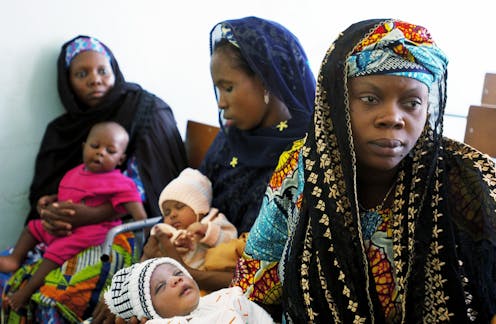
Childbearing has an impact on the health of women, and the impact grows with the number of times a woman has been pregnant for longer than 24 weeks. Pregnancy and breastfeeding put energy demands on a woman and can cause permanent changes to a mother’s health.
What’s less well known is the relationship between parity and oral health. That’s despite a widespread customary belief that having an increasing number of children results in tooth loss. “Gain a child, lose a tooth”, or “for every child, a tooth is lost” are common proverbs in many societies. The biological basis of these beliefs is still questioned.
There are few studies on parity and tooth loss. In addition, the available results are inconsistent. Nevertheless, increasing number of children in women has been associated with tooth loss in some populations, as seen in studies in Uganda and the US.
We decided to study this relationship to add to the evidence. Our study of rural women in northern Nigeria looked at how age, reproductive and socioeconomic factors and oral health practices contributed to tooth loss.
We found that women with more than five children lost more teeth than women of the same age who’d had fewer children.
Tooth loss matters because teeth are important for both functional and aesthetic roles. The loss of a tooth affects an individual socially, functionally and psychologically, negatively affecting their quality of life. Tooth loss can affect beauty, self-esteem, mastication, speech and social interaction.
Tooth loss
Our study involved 612 women who live in rural northern Nigeria. They were between the ages of 13-65. They all identified as Hausa. We decided on this cohort because women in this area have very high fertility rates. Nigeria has a total fertility rate of 5.7 children per woman. However, in the northwest zone where Hausa and closely related Fulani populations are predominant, the rate is 7.3.
Sociodemographic status and oral health practices were collected using a questionnaire. All teeth present (excluding third molars) and missing teeth were noted.
Generally, tooth loss experience in the participants was low: an overall prevalence of 14.1%. This means that 14% of women had lost some teeth. The presence of tooth loss in the women differed based on how many children they’d carried beyond 24 weeks, with more tooth loss experienced among women who had had more children.
There was no discernible pattern between tooth loss and number of children among those with fewer than five children.
At five children and above, tooth loss increased with each additional child.
The participants in the study displayed generally similar socio-economic statuses and dental service usage. This reduced the potential effects of other factors such as dietary quality and oral health status that can result in tooth loss.
The results showing a relationship between child bearing and tooth loss were as we had expected. Importantly, the duration of reproduction (the span of reproductive years) was found to be a critical contributor. Women who had children over a longer period of time lost significantly more teeth.
Also, socio-economic status contributed significantly to tooth loss, as women of middle socio-economic experienced significantly greater tooth loss. This was age related, most women in the middle socio-economic class were older while those in the low socio-economic status were younger.
Age played a significant role more generally too. Our study found that age was strongly associated with tooth loss. Tooth loss is typically the culmination of degenerative biological processes rather than an event. The longer the tooth is in the oral cavity, the greater the probability that it is exposed to the factors leading to tooth loss. In addition to the effects of increasing age, women face heightened risks stemming from their reproductive histories.
Hormones and tooth decay
Tooth loss is the result of multiple processes involving infection and weakening of the tooth structure or supportive tissues. Diet, hormonal changes, oral hygiene and dental treatment all play a part. In addition, teeth can be lost to trauma and cosmetic cultural practices. Gum disease following tooth decay is a major cause of tooth loss.
Gender-based differences exist in oral health, with more tooth loss in females than males. This is largely attributed to the role of female sex hormones, pregnancy and reproductive history. Estrogen levels are higher during pregnancy than during any other period in the life cycle. Pregnancy reduces the buffering capacity of saliva and promotes growth of bacteria that cause tooth decay.
Estrogen and progesterone are known, among others, to inhibit a body’s ability to produce a normal immune response. This is known as immunocompetence. The result is faster tooth decay.
Way forward
This study highlights the need to give more attention to the oral health of women during the reproductive years, in particular those who have many children.
Generally in Nigeria, the use of dental care service is poor due to limited availability and accessibility of oral health clinics. This affects early treatment of dental problems, which contributes to more tooth loss. Furthermore, dental problems are not considered as life threatening, thus low priority is given to dental care.
We found in our study that pregnancy and maternity made women even less likely to use oral healthcare service.
Oral health should be incorporated into the general healthcare. Dental care should also be made available and accessible to the general public, especially to those in the rural communities. And women’s oral health should be monitored as part of pregnancy support too.
There is need for oral health awareness and education too to identify barriers to dental care services.
Elizabeth Oziegbe does not work for, consult, own shares in or receive funding from any company or organisation that would benefit from this article, and has disclosed no relevant affiliations beyond their academic appointment.
This article was originally published on The Conversation. Read the original article.







